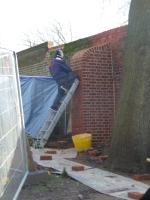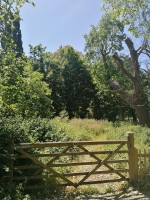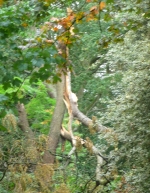2021
News Update
As at 6 May 2021
 Dutch Garden wall
Dutch Garden wall
The work of repairing the wall along the north side of the Dutch Garden has been completed. Specialists Pierra added buttresses at the west end of the wall, which was off-straight, and repointed the brickwork. They worked carefully around the Melancholy Man who is now enjoying a more secure setting. Now this is done, we very much hope attention will be given to much needed improvement of the Mediterranean Bed.
Woodland Survey Completed
The survey of the park’s woodlands has been completed and we await the full report with interest. The RBKC Ecology Service commissioned Land Use Consultants (LUC) to carry out drone and on-the-ground assessments of habitat classification, structure and composition as a first stage. Based on the habitats found, LUC will consider each area’s suitability for different types of flora and fauna using ‘indicator’ plants to determine what will grow best in the area. The survey will also tell us which invasive species need to be dealt with if they are not to outcompete everything else.
 This work is essential to creating and maintaining healthy and sustainable woodlands. Without it, planting would be guesswork and plants might not take at all, or might actually do damage to existing vegetation. Even ‘woodland mix’ might be completely inappropriate in woodland.
This work is essential to creating and maintaining healthy and sustainable woodlands. Without it, planting would be guesswork and plants might not take at all, or might actually do damage to existing vegetation. Even ‘woodland mix’ might be completely inappropriate in woodland.
Dr Mark Spencer, in his recent talk on wildflowers for the Ecology Service, warned against wildflower planting without a thorough understanding of the habitat, what already grows there and what will grow there naturally. Mark says: ‘So often, the underlying problem is a huge bias in people’s perception that plants are inactive, pretty backdrops to nature and not the dominant powerhouse they actually are.’
The intended output from LUC’s habitat survey is a Holland Park Woodland Management Plan, and this will provide a blueprint for planting of trees, shrubs and smaller plants, as well as for habitat maintenance.
 Woodland management sounds simple, but it is not. It is doubly difficult when the trees were all planted at the same time, as is the case with Holland Park’s woodlands. They are not ancient, ‘natural’ woodlands. That means many of the trees are dying at the same time. Only this May, RBKC tree officers found more failing trees in the woodlands and, when these are large trees, the risk of branches dropping cannot be accepted. A large poplar and a large horse chestnut will have been felled by the time you read this. More trees have been earmarked for dead wood removal. It is always sad to lose wonderful old trees, but it has to happen if safety is at stake, and the solution is to plant new trees. It must be said, the Council have been very slow to start this in Holland Park, and The Friends regularly chase up regarding the agreed long-term tree strategy. An assessment of trees in Arboretum 1, Arboretum 2 and the woodland space to the immediate west of the Acer Walk has been completed and there is space for some new trees. The Friends await sight of the assessment so that we can get the planting started. These Arboreta are designated as meadows, so the plan is for interesting trees, not too densely planted, so that the meadows can benefit from light between the canopies. We understand that the Arboretum 1 (East of the Acer Walk) is about to be scythed, to hold back the grass and let the resident wild flowers flourish. There used to be pignut (Conopodium majus) growing in this area, and it will be interesting to see whether it returns.
Woodland management sounds simple, but it is not. It is doubly difficult when the trees were all planted at the same time, as is the case with Holland Park’s woodlands. They are not ancient, ‘natural’ woodlands. That means many of the trees are dying at the same time. Only this May, RBKC tree officers found more failing trees in the woodlands and, when these are large trees, the risk of branches dropping cannot be accepted. A large poplar and a large horse chestnut will have been felled by the time you read this. More trees have been earmarked for dead wood removal. It is always sad to lose wonderful old trees, but it has to happen if safety is at stake, and the solution is to plant new trees. It must be said, the Council have been very slow to start this in Holland Park, and The Friends regularly chase up regarding the agreed long-term tree strategy. An assessment of trees in Arboretum 1, Arboretum 2 and the woodland space to the immediate west of the Acer Walk has been completed and there is space for some new trees. The Friends await sight of the assessment so that we can get the planting started. These Arboreta are designated as meadows, so the plan is for interesting trees, not too densely planted, so that the meadows can benefit from light between the canopies. We understand that the Arboretum 1 (East of the Acer Walk) is about to be scythed, to hold back the grass and let the resident wild flowers flourish. There used to be pignut (Conopodium majus) growing in this area, and it will be interesting to see whether it returns.
 In anticipation of the LUC report, The Friends are assisting the Ecology Service by creating a list of possible trees for planting in the woodlands. The intention is that our native trees are represented, but not all of them are likely to survive the expected change in climate. We can already see that birches are struggling in London parks. Some native trees simply will not cope, so we are adding appropriate species that will be Britain’s trees of the future. The advice is to look at what species of tree currently thrive in southern France and in Spain, on the assumption they will like the climate coming to our shores. Do not look at trees from northern climes.
In anticipation of the LUC report, The Friends are assisting the Ecology Service by creating a list of possible trees for planting in the woodlands. The intention is that our native trees are represented, but not all of them are likely to survive the expected change in climate. We can already see that birches are struggling in London parks. Some native trees simply will not cope, so we are adding appropriate species that will be Britain’s trees of the future. The advice is to look at what species of tree currently thrive in southern France and in Spain, on the assumption they will like the climate coming to our shores. Do not look at trees from northern climes.
It is worth making the effort to ensure our wildflower and tree planting is sustainable, and that future generations can enjoy Holland Park’s woodlands as much as we do. Done correctly, this will ensure the park enjoys healthy woodlands for years to come.
[Summer2021]
